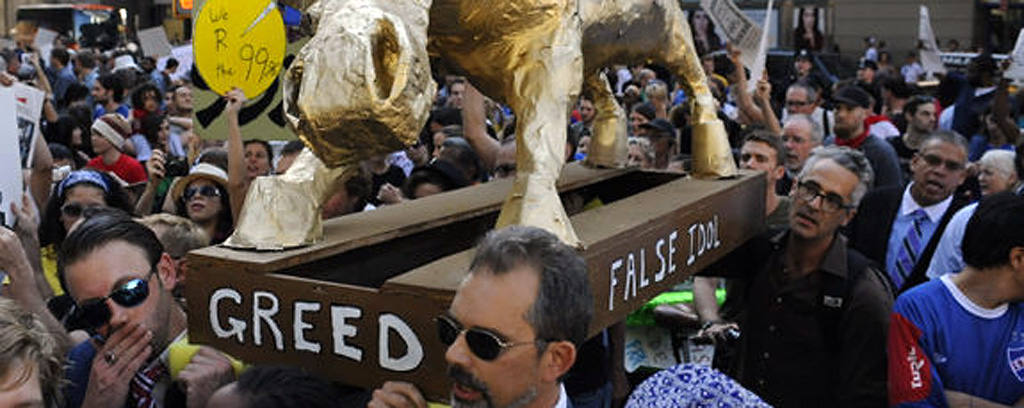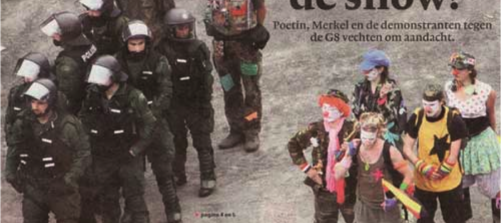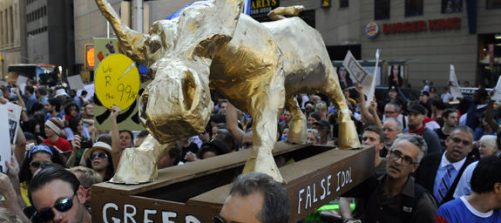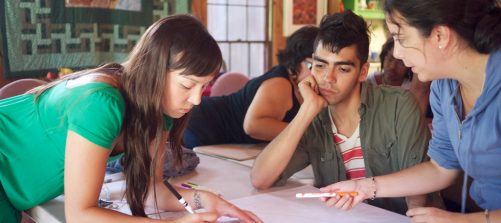Artistic activism and cultural resistance: An interview with Stephen Duncombe
In 2002 Stephen Duncombe, theorist provocateur, published his Cultural Resistance Reader in which he laid out a theoretical framework to assess resistant practices in the field of culture. During the past decade Duncombe succeeded in linking theory and practice of cultural resistance and artistic activism. Together with Steve Lambert he founded The Center for Artistic Activism (CAA) in 2010. He is not only involved in various platforms that provide people with an infrastructure to share, discuss, and analyze strategies of cultural creativity and civic engagement but also researches questions such as on how artists think about efficacy in bringing about real-world change through creative practices (artisticactivism.org). In the beginning of 2013 Elke Zobl and Florian Bettel have asked the scholar – he is Associate Professor of Media and Politics at New York University –, author, and activist about his experiences with contemporary movements, new technologies, the longing for “sanctification” through art, and the institutionalization of cultural resistance.
In the introduction of your Cultural Resistance Reader from the year 2002 you have drafted different scales of resistance; analyzing the social unit (individual to societal), the result (survival to revolution), and the political self-awareness of cultural production. Do you think your model is still valid and may be applicable to look at new movements (and their successes and disappointments) such as Occupy Wall Street?
Since putting together that reader on Cultural Resistance I’ve done quite a bit of re-thinking about the concept of “resistance”. The question that I think needs to be asked is not “resistance to what?”, as I think this is often self-evident, but rather the much more difficult question of: “resistance for what?”. This means asking ourselves – and this is a question that all of us engaged in the Occupy movement need to ask – if the point of resistance is merely to resist, or is resistance merely a necessary step toward something bigger, namely the transformation of the existing order, that is: revolution?
I worry sometimes that “resistance”, in itself, can end up supporting rather than changing the system. Resistance depends upon the system it is resisting. It’s the old problem of the relationship between the bourgeoisie and the bohemian. What is a bohemian if there is not the bourgeoisie to reject? (And what is the bourgeoisie if they don’t have bohemians to distance themselves from?) The problem with resistance as a permanent strategy is that it also situates the system as a permanent adversary. The result is an eternal and uncomfortable embrace. Not exactly a winning strategy for transformation.
Considering the far-reaching changes in digital media and communication, and the resulting shifts in journalism (e.g. WikiLeaks), culture (e.g. Twitter, Facebook, YouTube, AppStore vs. MegaUpload, etc.), and politics (e.g. online campaigns, Arab Spring, etc.) is it necessary (or possible) to append technology (to which degree it contributes to the initiative, analog/digital, DIY/professional, etc.) as the fourth dimension to your scales of resistance? How deep are technology and culture intertwined?
Technology – particularly communications technology – and culture are deeply intertwined. I think it’s useful to think of technology architecturally. Architecture sets limits on where we can and cannot go; it erects walls as well as passageways. Communications technology does the same, but unlike architectural space, these walls and passageways are not physical, but mental. For example: the printed page. Once literacy became commonplace it helped determine the parameters of our imagination. Reading right to left (or left to right) and moving from the top of the page to the bottom, creates a certain type of thinking: one defined by linearity, cause and effect, etc.
We are now in the midst of another communications revolution and while it is too soon to determine its impact on our culture with any exactitude, I think we can see a few of its – political – effects. Using the web, for example, is the experience of interacting with a multitude of perspectives and the networked distribution of information. This, in turn, conditions the way we think about other things: ideologies and hierarchy, for example. Occupy Wall Street, with its plethora of individualized “demands” made via protester placards, and the horizontal decision making process of the General Assemblies, could be said mimic the experience of using the web. This is the real impact of technology on contemporary protest. Not how technology is used by protestors – e.g. “the Facebook revolution” – but how technological protocols shape protest. The critic Lionel Trilling once called the protests of the 1960s “modernism in the street”; Occupy Wall Street was the “Internet in the streets.”
Have you come across examples of how cultural resistance can go beyond a “resisting against” and transfer political content into real (social, cultural, political) change? What significance do you see in civic engagement through cultural creativity? Who can participate and who not?
This is the big question. Can, and under what conditions, does resistance lead to social change? I think there’s no doubt that the “resistance” we saw in the Arab world beginning in Spring 2011 lead to real social change, most immediately: the downfall of dictators and regime change. But resistance, by itself, was not enough to usher in the new governments that many resisters wanted. Case in point: the rise of the Muslim Brotherhood in Egypt. The Muslim Brotherhood were late to the resistance and never had a major role, but what they did have was a long history of organizing and, consequently, a strong organization. There’s an important lesson here: resistance can be useful in unsettling the old order, but in order to build a new society you also need planning and organizing.
Art and its role
What specific role does art play in cultural resistance?
It depends upon how you define art. If you define it very narrowly, as something created by sanctioned artists and primarily experienced in galleries, museums and concert halls, then the answer to the question is: not much. However, if we define the term more broadly to include all creative expression – music, movement, visualization – then art is the foundation of cultural resistance. If art is defined this way then cultural resistance is a form of politics that expresses itself through the arts.
In your experience, are there certain artistic strategies that are more fruitful to express cultural resistance than others?
I think so. Art in its rarified form tends to alienate more than it attracts, which is never good for building a movement. The popular arts, that is, arts that speak in the vernacular of the population: popular music for instance, or even the appropriation of commercial culture like advertising, have a much better chance of reaching a wider public as they speak in a language that people already understand. I’d go even further: it is because they use a familiar form that these sorts of arts are so effective. They offer a comfortable, safe stepping stone to the often more foreign and threatening world of political engagement – a sort of gateway drug.
That said, I think there’s a place for an Avant-garde that produces artistic expression that is largely illegible to much of the population; art that does not speak in a familiar language but suggests a new language, a new way of looking at and understanding reality. (Indeed, this is my favorite kind of political art.) But this sort of politics of art is of limited use in an activist campaign seeking immediate popular support and short-term change.
How do people produce culture actively (by using art)? Can you tell us about some interesting examples you have come across?
There are so many. I’d direct readers to a open-source, user-generated database of creative activism co-created by the CAA and the Yes Labs called Actipedia (actipedia.org). I’d also encourage readers to post their own examples here.
In one of your interviews you state, “we think activism is, or rather it should be, an art: creative and inspirational”. Still, there is some criticism to phasing art and political activism, for example by posing the provoking question why some resistance would strive for “sanctification” through art (see Jürgen Riethmüller, p/art/icipate 2/2013).
Again, it’s all about how you define art. If you think of art as something created by specialists for a specialized audience, then yes: there is no need for activists adopting the mantle of an “artist” producing “art.” As I suggest above, such “sanctification” is actually harmful. But if you think about art as something we all do and enjoy: DJing on a Saturday night or going out dancing, creating scrap books or listening to our favorite bands, or even just going out to a movie or watching TV – if we include these activities in the creation and consumption of “art,” then art actually de-sanctifies. Defined this way, artistic expression is something practiced and embraced by far more people than activism is. As such, activism that is also artistic opens up the practice.
Complementary, there are artists who deliberately stem the equation of art and activism by being either artist or activist – never both at the same time (see Queering Yerevan p/art/icipate 2/2013). Does art have the freedom of not being political? What could be a historical perspective to this question?
Yes and no. I’m enough of a Marxist to believe that all cultural expression is always a reflection of, or reaction against, the dominant social, political and economic conditions. The idea of “autonomous art” is ridiculous. On the other hand, there is art which is consciously political and art that is not. I’m honestly not interested in the latter (except as an individual who likes to go to galleries and museums); I’m interested in working with artists and activists who consciously want to change the world and help them to use their art and creativity to do this.
Institutionalization
Together with Steve Lambert you have founded the CAA to share, discuss, and analyze tactics and strategies of artistic activism, and to link up the many groups and individuals who stress cultural creativity in their civic engagement. How has this collaborative space for interdisciplinary researchers and practitioners in artistic activism developed since its conception? What has been your experience?
Artistic activism, in so far as it brings together art and activism in a hybrid practice, is inherently interdisciplinary. There is nothing I enjoy more than bringing together people trained in different perspectives. But in order to be productive I believe that one needs a common project, the more concrete the better. I’ve been at the academy long enough to have experienced the futility of interdisciplinarity when it means debating the meaning of art, or some other abstract concern. But if you bring people together to, say, plan a campaign to address the incarceration of young black and brown men in Texas, or expose the structural inequality of public budgeting in Massachusetts (we’ve done both), then difference becomes productive.
Units of your initiative are The School for Creative Activists, a training program for grassroots activists, The College of Tactical Culture, a think-tank of artists, activists, designers and attorneys, and the Art Action Academy, a workshop to help socially engaged artists become more politically efficacious. Can you tell us more about how (and for whom) you transfer theory and practice into teaching and workshops?
It’s nothing mysterious. We introduce a lot of examples, history, theory and techniques so we all have a common vocabulary. We do exercises to help people tap into their own creativity and understand the power of envisioning alternatives. And then we workshop solutions to real-life problems that people are working on. It takes a lot of time and a lot of effort all around, but like I said, it’s basically pretty simple. We are in the process of making our entire curriculum downloadable (for free) on our CAA website, so people can see what we do for them.
And finally, what is your personal outlook for the future? Where do you think we are heading regarding developments in art, politics, and cultural resistance?
All effective activism has been creative activism. This was true for Jesus of Nazareth who staged performative protests in the main temple of Jerusalem when he kicked over the tables of the money changers or acted out a pre-figurative politics by asking women, tax-collectors, prostitutes, and the disabled to have dinner with him. It was also the case during the Civil Rights Movement here in the US which dramatized reality through acts like Rosa Parks refusing to give up her seat on a segregated bus. Or the campaign to desegregate Birmingham, Alabama, in which King and his lieutenants selected the location precisely because they knew they would meet violent resistance thereby playing out the reality of racism before the world’s news media. Or a much darker example: the spectacles and performances of the Nazi Party.
But there’s also no doubt that the conscious merging of arts and activism has become more prominent in recent decades. I think this makes sense. As we are fond of repeating at the CAA: The first rule of guerilla warfare is to know your terrain and use it to your advantage. The political topography of today is one of signs and symbols, stories and spectacles. In order to be an effective activist you have had to learn how to operate on this aesthetic terrain.
Where I hope we are heading is the wider adoption and adaptation of creative perspectives amongst grass-roots activists. This is what we are trying to do through the School for Creative Activism and our other projects. I hope we are also heading toward a more reflective and critical practice of creative activism; a practice that continually asks of itself: does it work? And then, how can we make it work better?
Thank you for the interview!
Thank you for your interest!
Florian Bettel, Elke Zobl ( 2013): Artistic activism and cultural resistance: An interview with Stephen Duncombe. In: p/art/icipate – Kultur aktiv gestalten # 02 , https://www.p-art-icipate.net/artistic-activism-and-cultural-resistance-an-interview-with-stephen-duncombe/





 Artikel drucken
Artikel drucken Literaturverzeichnis
Literaturverzeichnis